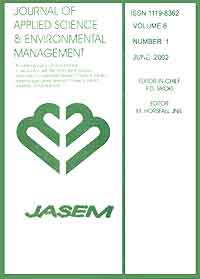
|
Journal of Applied Sciences and Environmental Management
World Bank assisted National Agricultural Research Project (NARP) - University of Port Harcourt
ISSN: 1119-8362
Vol. 20, No. 3, 2016, pp. 635-643
|
 Bioline Code: ja16075
Bioline Code: ja16075
Full paper language: English
Document type: Research Article
Document available free of charge
|
|
|
Journal of Applied Sciences and Environmental Management, Vol. 20, No. 3, 2016, pp. 635-643
| en |
Electricity Generation in Nigeria from Municipal Solid Waste using the Swedish Wasteto- Energy Model
AKHATOR, E.P.; OBANOR, A.I. & EZEMONYE, L.I.
Abstract
Waste-to-energy (WTE) technology in Nigeria is still at the infancy stage
whereas in Sweden the technology is now so advanced that energy in the form of heat and
electricity has commercially been recovered from waste. This study examines waste-toenergy
development and its success factors in Sweden with a view to instigating the
deployment of a modified Sweden’s waste-to-energy model in Nigeria to enhance her WTE
capacity. The study was carried out in two phases. The first phase involved field visits to
some waste-to-energy plants in Sweden and the second phase was a desk research of
available data on current WTE development in Nigeria, Sweden’s energy sector as well as
factors responsible for its successful WTE development. The result from the study showed
that Sweden generated about 2.0TWh of electricity from about 5.7 million tonnes of waste
in its WTE plants in 2014. The success of WTE development and growth in Sweden is
hugely as a result of the support from the Swedish government via enacting enabling
policies and adequate funding. With about 14 million tonnes of combustible waste available
in Nigeria, about 4.4TWh of electricity could be generated annually if WTE development in
the country receives similar support from the Nigerian government. © JASEM
Keywords
Electricity generation; Municipal solid waste; Renewable energy; Solid waste combustion; Swedish waste-to-energy model; Waste-to-energy development
|
| |
© Copyright 2016 - Journal of Applied Sciences and Environmental Management
|
|
